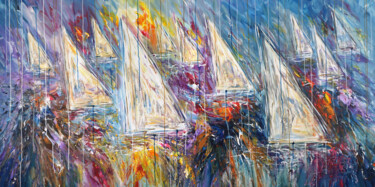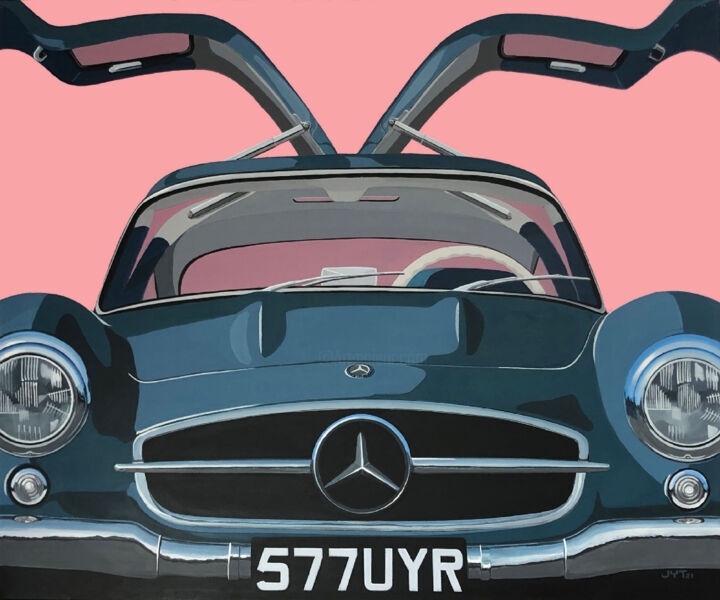 Jean-Yves Tabourot, Gullwing, 2020. Acrylic on canvas, 110 x 130 cm.
Jean-Yves Tabourot, Gullwing, 2020. Acrylic on canvas, 110 x 130 cm.
Was Leonardo da Vinci who invented the first machine?
During the course of his life, Leonardo da Vinci took note of his studies, observations and reflections in notebooks and codices, often illustrated with sketches and detailed drawings. To date, have been identified and consequently well preserved, promoted and valorized about 4,000 sheets by his hand, in which the 'prototypes' of the submarine, the hang-glider, the parachute, the helicopter. However, these cutting-edge machines were only imagined by the Italian genius, who, most likely, did not have adequate technology to make them concrete. According to the iconic art historian Giorgio Vasari, however, such inventions were not completed by Leonardo because of his scattered and inconclusive temperament: "So, truly admirable and heavenly was Lionardo, [...]. And most of all in erudition and principles of letters, in which he would have made a great profit, if he had not been so varied and unstable. Therefore, he set himself to learn many things and, having begun, then abandoned them" (The Lives of the Most Excellent Painters, Sculptors, and Architects, Giorgio Vasari, XVI century). In this context, it is worth noting that, among the many anticipatory inventions attributed to the Tuscan genius, there could also be that of the automobile, whose most remote project can be traced back to a drawing in the Codex Atlanticus, which, dated 1478, is called the spring car. In fact, this paper sketch represents to all intents and purposes the model of the first self-propelled vehicle in the world, consisting of three wheels capable of moving without being pushed. This invention therefore represents, in all respects, a primordial prototype of an automobile, even if its intended use was quite different from that for which modern cars were invented. Just recently, the hypothesis that the self-propelled wagon was actually a theatrical machine, with the purpose of creating special effects through its short and autonomous movements, has been officially accepted. After all, it is well known that Leonardo carried out many activities, including that of director and set designer at the court of Ludovico il Moro (Milan), an activity in which he could put into action both his creative imagination and his ability to design machines and apparatus.
 Ivan Boussion, Ferrari GTO. Painting, 80 x 120 cm.
Ivan Boussion, Ferrari GTO. Painting, 80 x 120 cm.
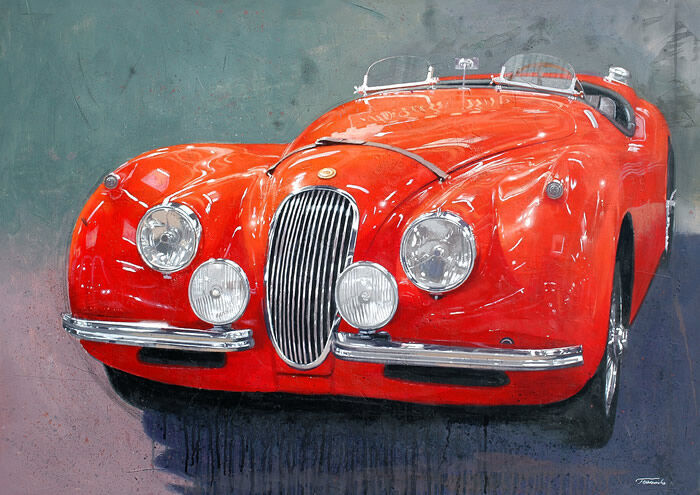 Paco Ferrando, Jaguar, 2007. Acrylic and oil on canvas, 65 x 92 cm.
Paco Ferrando, Jaguar, 2007. Acrylic and oil on canvas, 65 x 92 cm.
Cars in works of art
The link between artists and cars continues in the greatest masterpieces of art of all time, that is, in sculptures, paintings, photographs and prints, which have immortalized this iconic means of locomotion, following multiple points of view and figurative techniques. An example of what has been said are the works of great masters such as Andy Warhol, Wolf Vostell, Birgit Kinder, Salvador Dali, Giacomo Balla and Roy Lichtenstein. About the most famous master of Pop art, Andy Warhol, he, who didn't even drive, realized, with the intent to celebrate the life style of the consumer society, some works dedicated to Merceds-Benz, entitled Cars. In fact, it was the German car manufacturer that commissioned him, in 1986, a series of paintings, screen prints and drawings concerning the evolution of their vehicles. The American artist completed 49 of the 80 planned pop pieces, which were reproduced from photographs in Warhol's typical style. Finally, the works commissioned by Mercedes-Benz, which are part of Daimler's art collection, turn out to be nothing short of precious and little publicized, as they were only exhibited in full in 1988, 2010 and 2014. Finally, another artist who, while rarely driving, dedicated some of his work to the fascination of automobiles was Salvador Dali, who included vehicles in many of his paintings, collages, and installations. In particular, in 1941, through the work Dressed Automobiles, Dali used the car to generate enigmatic images, aimed at giving new meanings to the viewers' vision, breaking down and transforming reality. In fact, in the iconic collage, the Spanish master literally dresses a Cadillac with elegant clothes, worthy of a high fashion boutique.
 Sylvie Julkowski-Egard, Mercédès Benz Cabriolet, 2020. Linen oil on canvas, 80 x 80 cm.
Sylvie Julkowski-Egard, Mercédès Benz Cabriolet, 2020. Linen oil on canvas, 80 x 80 cm.
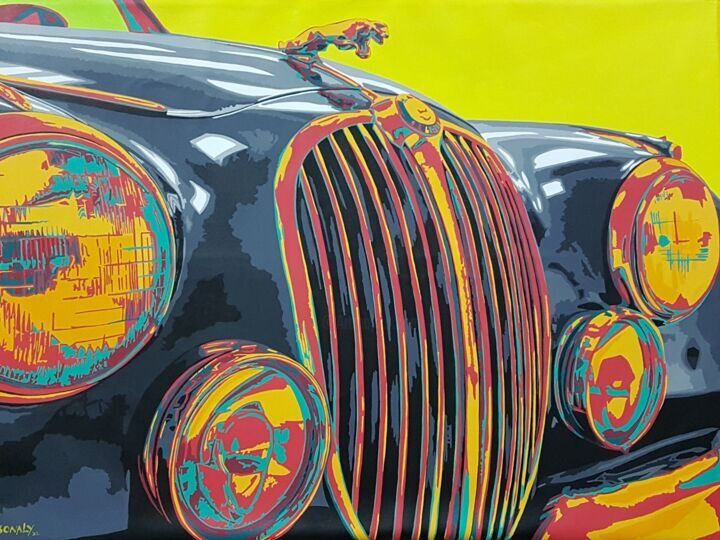 Sonaly Gandhi, Automobiles - classic meets pop - Jaguar mark 1960, 2022. Acrylic on canvas, 91.4 x 121.9 cm.
Sonaly Gandhi, Automobiles - classic meets pop - Jaguar mark 1960, 2022. Acrylic on canvas, 91.4 x 121.9 cm.
Cars as works of art
Cars have not only been painted, drawn, sculpted and photographed. In fact, on some occasions, the world's most famous artists have also created works by manipulating real vehicles, by creating decorations or installations of impact, which have given rise to original and unprecedented masterpieces. A famous example of this is the Audi R8, which, decorated by Kusama with its iconic dots, is the result of the collaboration between the Japanese artist and the well-known German car manufacturer. On this occasion, Kusama wanted to embellish the car with red dots, taking up the motif of the rising sun from the flag of his country. Still on the subject of decorative collaborations, the forerunner of this trend was BMW, which, since 1975, created a long-term link between art and its cars. In fact, from that date onwards, many artists have worked with the German brand, including Alexander Calder, David Hockney, Jenny Holzer, Roy Lichtenstein, Robert Rauschenberg, Frank Stella, Andy Warhol and the more recent Jeff Koons. On the other hand, with regard to installations made with cars, in the world of contemporary art Maurizio Cattelan's Untilted (2000) stands out, in which a new and immaculate Audi Quattro has been pierced in the middle by a tree. This artistic project, part of the expo 2000 in Hannover (Germany), left viewers in disbelief wondering about the meaning of the work, which was interpreted as nature's probable revenge against the degradation of global warming.
 João Bello (JBello Studio), Hoonicorn drift car II, 2021. Acrylic on canvas, 50 x 75 cm.
João Bello (JBello Studio), Hoonicorn drift car II, 2021. Acrylic on canvas, 50 x 75 cm.
Cars in the artworks of Artmajeur's artists
Just like the greatest masters mentioned above, the artists of Artmajeur have also been inspired by cars, which they have portrayed in paintings, digital works, sculptures and drawings, immolating the most iconic and luxurious models with personal "realism". Examples of the above are offered to us by Caspa's digital print, Antoine Dufilho's sculpture and Eric Berthet's drawing.
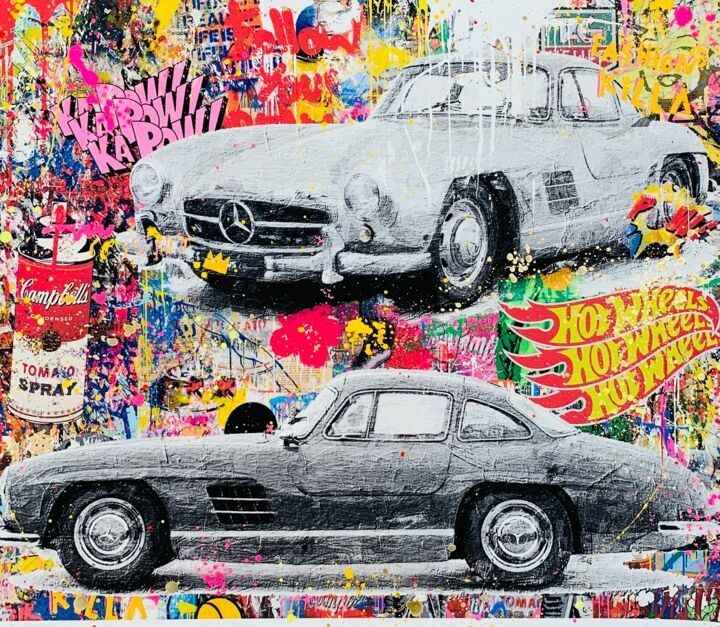 Caspa, Classic Mercedes, 2022. Digital print / acrylic on paper, 50 x 60 cm.
Caspa, Classic Mercedes, 2022. Digital print / acrylic on paper, 50 x 60 cm.
Caspa: Classic Mercedes
The digital painting with Pop and colorful background immortalizes, in its main subjects in black and white, two iconic Mercedes 300 SL, captured from different points of view, aimed at highlighting its legendary design. In fact, the meaning of the work seems to be built entirely on the popularity of this model, which is celebrated, along with other iconic brands, as a real "super star". In fact, the Mercedes 300 SL, born in 1952, represents a true legend of the German brand, known especially for its famous doors hinged upwards. In addition, this car won important competitions, such as the Berne Prize for sports cars, the legendary 24 Hours of Le Mans, the Jubilee Grand Prix for sports cars at the Nürburgring and the 3,100 km road race through Mexico, the Carrera Panamericana.
 Antoine Dufilho, Porsche 930 Turbo, 2021. Sculpture, aluminum / stainless steel on other support, 38 x 85 x 21 cm.
Antoine Dufilho, Porsche 930 Turbo, 2021. Sculpture, aluminum / stainless steel on other support, 38 x 85 x 21 cm.
Antoine Dufilho: Porsche 930 Turbo
Antoine Dufilho's sculpture reproduces with original formal, material and chromatic peculiarities the design of a Porche 930 Turbo, enriching it with a strong sense of dynamism, which seems to invest the work in a perpetual burst of speed. From a historical point of view, however, the aforementioned model of sports car, produced by the German car manufacturer between 1975 and 1989, remains an indelible cult in the memory of Germans, since, at the time of its introduction, it was the fastest available in Germany.
 Eric Berthet, L'Alfa Roméo Giulia GTA, 2021. Drawing, ink / graphite on paper, 40 x 50 cm.
Eric Berthet, L'Alfa Roméo Giulia GTA, 2021. Drawing, ink / graphite on paper, 40 x 50 cm.
Eric Berthet: L'Alfa Roméo Giulia GTA
The hyperrealism of Berthet's ink and graphite drawing on paper is perfect for carefully capturing every single detail of Alfa Romeo's iconic racing model. In fact, the Giulia GTA was produced by the Italian automaker, between 1965 and 1975, in order to replace the TI Super sedan in Turismo races. the Giulia GTA, more powerful and lighter than the previous models, launched at the Amsterdam Motor Show, won a series of successful competitions, becoming a very famous model, as well as a worthy symbol of an era.


 Olimpia Gaia Martinelli
Olimpia Gaia Martinelli
















